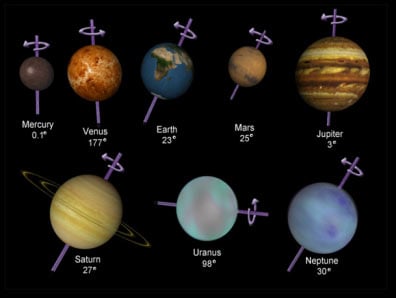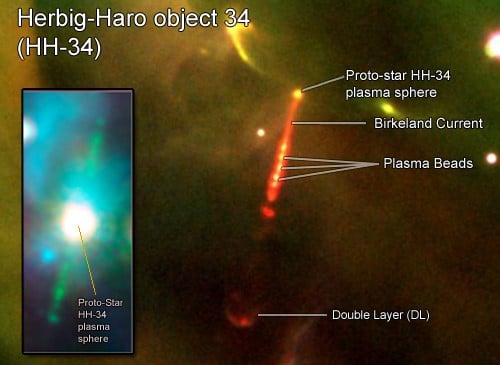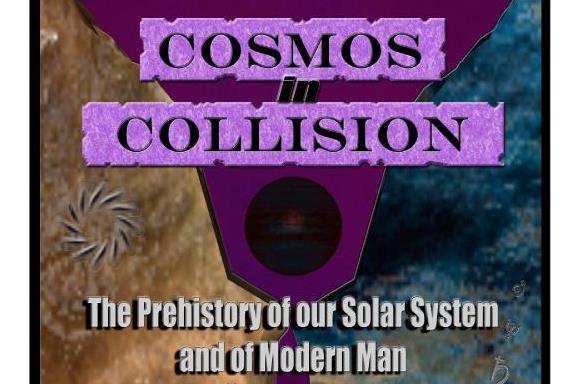The Ganymede Hypothesis - Part 1: The Original Double Solar System
Consider the axis tilts of planets in our system. If our system had formed from a swirling disk of solar material as textbooks claim, all axial tilts should be approximately the same, that is, all near zero with all axes of the planets roughly perpendicular to the plane of orbit. The sun, Jupiter, and mercury do in fact show that. Uranus and Venus are odd cases out with their own explanations, but Neptune, Saturn, Mars, and Earth all have axis tilts of 23.4 - 27 degrees.
 The explanation which suggests itself is as follows: Our sun, Jupiter, and Mercury, with their axes roughly perpendicular to the plane of the system, form one part of the ancient system; Uranus and Venus are odd cases with their own separate explanations; Neptune, Saturn, Mars, and Earth, with their spin axes roughly 26° to the plane of the system, comprise what once was a separate system, which must have been captured by our present sun as a group.
The explanation which suggests itself is as follows: Our sun, Jupiter, and Mercury, with their axes roughly perpendicular to the plane of the system, form one part of the ancient system; Uranus and Venus are odd cases with their own separate explanations; Neptune, Saturn, Mars, and Earth, with their spin axes roughly 26° to the plane of the system, comprise what once was a separate system, which must have been captured by our present sun as a group.
The normal reaction is to assume that this occurred hundreds of millions of years ago. Ancient literature says it occurred a few thousand years ago. Primitive people seeking to devise an astral religion today would end up worshiping the sun and moon, but the two chieftain gods of all antique religions were Jupiter and Saturn. Plato consistently refers to antediluvians as "Nurslings of Kronos(Saturn); the main religious festival in ancient Rome was "Saturnalia", our Sabbath is still called "Saturday". Hesiod and Ovid claim there was a golden age hen Saturn/Kronos was "King of Heaven", followed by the great flood, then a brief "Silver Age" when Jupiter/Zeus was "King of Heaven", followed by the Trojan war and our present "Iron Age". In the same language, our sun is the "King of Heaven" now.
Herbig-Haro objects and the way in which the axis tilts of the Saturnian part of our system came about
Herbig-Haro objects are believed to be associated with proto-stars in their infancy, and the accepted view is that these baby stars are shooting out vast polar jets of gas along their rotational axis in which globules or beads of plasma collect in our now familiar ‘string of pearls’ analogy. These so-called beads maintain their axial alignment and rotation in step with the proto-star exactly in the manner suggested for the Earth/Saturn polar configuration. Here, in fact, is the elusive evidence pointing to the possibility that polar configurations are possible in the depths of space.
 What mainstream scientists identify as polar jets of hot gas are, in fact, Birkeland currents, the great interstellar and interplanetary transmission lines for the flow of electrical energy through interstellar space. The beads of plasma collecting along these Birkeland currents are where z-pinches are taking place. Z-pinches are extremely stable areas into which heavy elements like iron, ejected from the proto-star or drifting in interstellar space, are attracted and captured due to the intense magnetic fields associated with z-pinches. Some of these z-pinches fail to spark into full-blown main-sequence stars, and instead produce brown dwarfs, They even may produce the solid cores needed for the formation of terrestrial-type planets — and all this is happening along the same axial alignment of their proto-star’s shared rotation.
What mainstream scientists identify as polar jets of hot gas are, in fact, Birkeland currents, the great interstellar and interplanetary transmission lines for the flow of electrical energy through interstellar space. The beads of plasma collecting along these Birkeland currents are where z-pinches are taking place. Z-pinches are extremely stable areas into which heavy elements like iron, ejected from the proto-star or drifting in interstellar space, are attracted and captured due to the intense magnetic fields associated with z-pinches. Some of these z-pinches fail to spark into full-blown main-sequence stars, and instead produce brown dwarfs, They even may produce the solid cores needed for the formation of terrestrial-type planets — and all this is happening along the same axial alignment of their proto-star’s shared rotation.
The so-called ‘bow-wave shocks’ supposedly produced by the hot gas shooting out along the proto-star’s polar axis are nothing more than what plasma physics calls a ‘Double Layer’. These double layers, or DLs, are the signature effect of a Langmuir sheath, or, in other words, a plasma sheath; the same protective electrical cocoon we have already encountered when looking at the electrical environment surrounding brown dwarf stars. Their presence in Herbig-Haro objects is a dead giveaway that serious electrical activity is taking place, the kind of activity that produces intensely strong and attractive magnetic fields. Wherever you have powerful magnetic fields you have a recipe for potential planet and star-birthing activity; it is the magnetism at work that attracts heavy elements like iron to form a solid core.
It is this profusion of electrical activity that is most relevant to our assertion that Earth started off under Saturn according to this polar configuration model.
The lifespan of a Herbig-Haro object is relatively short, lasting in the tens of thousands of years. Things happen quickly where these objects are concerned, and they apparently begin to break up once the proto-star at its center develops into a fully-fledged main-sequence star like our current sun. Any brown dwarfs and their satellites attached to such a former proto-star will be released to form their own planetary nebula while finding their own way in space.
A brown dwarf star formed in this environment can be expected to maintain its own axially aligned Birkeland current even if it is severed from the main Birkeland current emanating from the main proto-star. Acting as a spinning homo-polar electric motor, or Faraday motor, the new brown dwarf star will generate its own electrical equilibrium as it feeds from the same general galactic electrical circuit that is also driving the main proto-star at the heart of the now breaking-apart Herbig-Haro object. In this way its axial tilt may change slightly, an important consideration when contemplating why Saturn came to have a different axial tilt to the Sun.
Part 2: Dark and bright sides of the ancient system
Part 3: Ganymede
By Ted Holden
Cosmos in Collision, a new book co-authored by Theodore A. Holden and Troy D. McLachlan, involves a startling claim: that the authors have pinpointed to within a statistical certainty the original home of modern humans on the largest of Jupiter’s moons, Ganymede. Hominid to human evolutionary schemes are shown to be unworkable; humans are shown to be highly maladapted to the conditions of this planet in very ancient times, implying that we could not plausibly have evolved or been created for this planet; Ganymede is shown to be the remains of what would have been a perfect world for Elaine Morgan’s “Aquatic Ape” thesis and for human habitation. By “to within a statistical certainty”, is meant that a zero probability event or probabilistic miracle would have to have occurred for anything other than what the authors are proposing, to have happened.

















